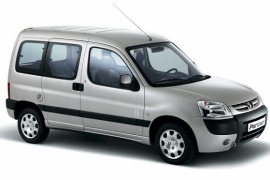PEUGEOT Partner Combi Models/Series Timeline, Specifications & Photos
First production year: 2002
Engines: Gasoline, Diesel
Body style: Van
Peugeot introduced a facelifted version for its LCV-based compact MPV Partner in 2002, fixing a few problems and updating the engine lineup.
Peugeot was not a big name on the MPV market, but it was better known for its light-utility vehicles. It combined the two areas, like the Volkswagen with the Caddy or Renault with the Kangoo, and the result was a compact-sized family vehicle that was very good for work too. While in the U.S., customers bought pickups to use them in both areas, the Europeans chose vans with removable seats.
The most important change for the Partner was the front fascia. It wasn't just a better-looking vehicle, but it offered bigger headlights. Its predecessor was often criticized for its weak headlights, like if its French parent built it for day-use only. To access the car, Peugeot installed two doors at the front and one on the curbside for the rear passengers. A second sliding door was on the options list. The car kept the same big liftgate in the back, which was very good as a roof in rainy weather.
Inside, Peugeot tried its best to make its customers happy with their MPV. Apart from the regular storage areas, the carmaker added some more on the ceiling above the windscreen and another one above the trunk area. Its high-mounted front seats couldn't make the driver feel like the Partner Combi was a regular hatchback, but the instrument cluster and the dashboard's shape were very close to one.
Under the hood, Peugeot installed a range of two gasoline and four turbo-diesels. They were all paired to five-speed manual transmissions.
